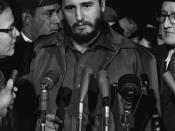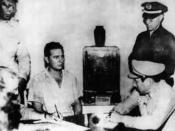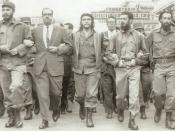Almost every nation in the world has experienced a revolution. A revolution can be simply defined as "a change." When a country undergoes a revolution, its ideals that it once believed in are being modified. Sometimes revolutionaries act intellectually, yet others may respond physically through destruction. Some may be peaceful, some short lasting, and some pointless. Historians do argue on identifying whether a revolution has occurred. Revolutions usually follow a rupture in the nation's events, are directed by a hero, have an ideology and belief system, and use symbols or tools to get its points across to the people. Cuba and its leader today, Fidel Castro, have their own roots in a revolution that took place only some forty years ago. The causes of the Revolution itself laid behind the military dictatorship of General Batista. In my paper I will combine the theories of revolutions by Walter Goldfrank and Timothy Crowley into a new encompassing theory.
While doing that I will apply it to the Cuban revolution.
After reading through the theories of Goldfrank and Crowley I have realized that there were four major points. The first, Permissive world Context: This will then apply to the military strength and legitimacy away from the state. Second, Political/Economic Crisis: This will apply the military strength and legitimacy away from the state. Third, Peasant Rebellion, this will apply the strong and sustained peasant support. Finally in comparison to both theories the Dissident political Elites, this applied the legitimacy away from the state.
The overthrow of the June 1952 elections by Batista indirectly led to the Cuban Revolution. With this event the weakness behind Cuba's politics was revealed to the people. Their economy also fluctuated between high and low profits. Because Cuba, after the destruction of land in Europe in WWII, had the...



Informative
thorough information provided, thnx
0 out of 0 people found this comment useful.